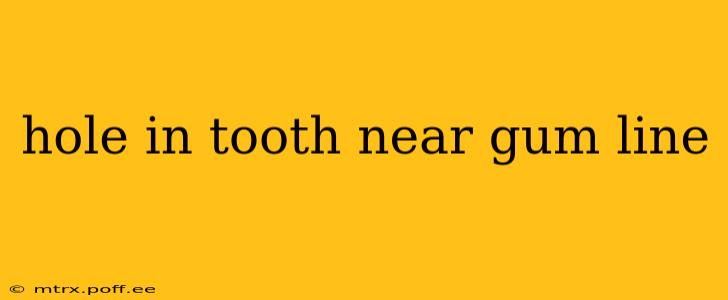A hole in your tooth near the gum line, often called a cavity or caries, is a serious dental problem requiring prompt attention. This location makes it particularly challenging to treat because it can be difficult to access and clean thoroughly. Ignoring it can lead to more extensive damage, including gum disease and tooth loss. This comprehensive guide will explore the causes, treatment options, and preventative measures for a hole in your tooth near the gum line.
What Causes a Hole in a Tooth Near the Gum Line?
The primary cause of cavities, regardless of location, is tooth decay. This occurs when bacteria in your mouth produce acids that erode tooth enamel. These acids are a byproduct of the bacteria feeding on sugars and starches in food and drink. The bacteria form a sticky film called plaque that adheres to your teeth. Over time, if plaque isn't removed through regular brushing and flossing, it hardens into tartar (calculus), which further exacerbates the decay process.
Several factors increase the risk of developing a cavity near the gum line:
- Poor oral hygiene: Insufficient brushing and flossing allow plaque to accumulate, particularly in hard-to-reach areas like the gum line.
- Diet high in sugar and refined carbohydrates: These foods provide the fuel for bacteria to produce acids.
- Dry mouth: Saliva plays a crucial role in neutralizing acids and washing away food particles. Reduced saliva production increases the risk of decay.
- Genetics: Some individuals are genetically predisposed to tooth decay.
- Existing dental work: The margins of fillings, crowns, or other restorations can become compromised over time, creating spaces where bacteria can thrive.
- Gum recession: As gums recede, more of the tooth root is exposed, making it vulnerable to decay. The root surface is less resistant to acids than enamel.
How is a Hole in a Tooth Near the Gum Line Treated?
Treatment for a cavity near the gum line depends on the severity of the decay:
-
Filling: For small cavities, a filling is usually sufficient. The dentist will remove the decayed portion of the tooth and fill the cavity with a composite resin, porcelain, or amalgam material. This procedure often requires a local anesthetic to numb the area.
-
Inlay/Onlay: For moderately sized cavities, an inlay or onlay might be necessary. These are custom-made restorations that fit precisely into the prepared tooth structure.
-
Crown: If the cavity is extensive, a crown may be required to protect the remaining tooth structure. A crown is a cap that covers the entire tooth.
-
Root canal: If the decay has reached the pulp (the inner part of the tooth containing nerves and blood vessels), a root canal treatment is necessary to remove the infected tissue and save the tooth.
What are the Long-Term Effects of Untreated Decay Near the Gum Line?
Leaving a hole near your gum line untreated can lead to several serious complications:
- Gum disease (periodontal disease): Infection from the cavity can spread to the surrounding gum tissues, causing inflammation, bleeding, and potential tooth loss.
- Abscess: A pus-filled pocket (abscess) can form at the root of the tooth, causing severe pain and potentially spreading infection to other areas of the body.
- Tooth loss: Severe decay can weaken the tooth structure to the point where it fractures or needs extraction.
How Can I Prevent Holes in My Teeth Near the Gum Line?
Preventing cavities requires a proactive approach:
-
Maintain excellent oral hygiene: Brush your teeth twice a day with fluoride toothpaste and floss daily. Use a soft-bristled toothbrush and gentle brushing techniques to avoid damaging your gums.
-
Eat a healthy diet: Limit your intake of sugary and refined carbohydrate-rich foods and drinks. Consider rinsing your mouth with water after consuming sugary substances.
-
Regular dental checkups: Visit your dentist for regular checkups and cleanings (typically every six months) to detect and treat cavities early.
-
Fluoride treatments: Fluoride strengthens tooth enamel and makes it more resistant to acid attacks. Your dentist can apply fluoride treatments during your checkups.
Does a Hole in My Tooth Mean I Need a Root Canal?
Not necessarily. A root canal is only necessary if the decay reaches the pulp (the soft tissue inside the tooth). A small cavity can often be treated with a simple filling. Your dentist will determine the appropriate treatment based on the extent of the decay.
Can I Fix a Hole in My Tooth Myself?
No, you should never attempt to fix a hole in your tooth yourself. This can lead to further damage and infection. It is essential to seek professional dental care to address a cavity.
How Much Does it Cost to Fix a Hole in a Tooth Near the Gum Line?
The cost of treating a hole in your tooth varies depending on the extent of the decay, the type of treatment required, and your location. It's best to contact your dentist for an accurate estimate.
This information is for general knowledge and does not constitute medical advice. Always consult a qualified dentist for diagnosis and treatment of any dental concerns.
